This evening we are back in the little town of Le Monastier where Robert Louis Stevenson first bought his donkey Modestine in 1878 before setting off on his travels through the Cevennes. It was from this spot that we set off to retrace his journey with our Modestine last October. The reason we are here is because, passing nearby around 6pm Modestine expressed a wish to see again the location that was the origin of her name. We indulged her whim with pleasure and the three of us are settled for the night on the Esplanade Stevenson in the centre of the town. There is a sense of nostalgia in finding ourselves back here and it is tempting to think of returning to Ambre-les-Espagnolettes to see friends again and to stock up on some of Mme. J's boxes of wonderful deep red wine! However, Venice is still beckoning – and we are slowly getting there!
 The landscape between Besse-en-Chandresse and St. Nectaire, Auvergne
The landscape between Besse-en-Chandresse and St. Nectaire, AuvergneOur first stop this morning was at St. Nectaire, a little town in two parts, with a beautiful 12 century Romanesque church on the summit of the hill above the town and the 19th century spa town down below with its thermal baths and petrified fountains. This part of the town looks a little run-down and decayed but there are some rather impressive hotels and public gardens. The church however is magnificent and certainly one of the nicest we have seen anywhere in the Auvergne, a region that is full of beautiful churches. As is common in the area there is an apse surrounding the altar supported on columns, with wonderfully carved capitals, some depicting events in the life of St. Nectaire.
 St. Nectaire, Auvergne
St. Nectaire, Auvergne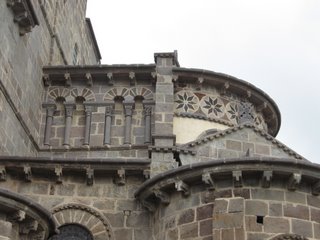 Detail of the apse at St. Nectaire, Auvergne
Detail of the apse at St. Nectaire, Auvergne Interior of St. Nectaire looking down the nave from behind the altar, Auvergne
Interior of St. Nectaire looking down the nave from behind the altar, Auvergne Capitals, St. Nectaire, Auvergne
Capitals, St. Nectaire, Auvergne 12th century Limoge enamelled book cover, Treasury, St. Nectaire, Auvergne
12th century Limoge enamelled book cover, Treasury, St. Nectaire, Auvergne 12th century painted wooden virgin and child, Treasury, St. Nectaire, Auvergne
12th century painted wooden virgin and child, Treasury, St. Nectaire, AuvergneAs we moved south beyond St. Nectaire the landscape changed and there was a more southern feel to the landscape. In the villages the black slate of the roofs was replaced by the red tiles so common in the Midi. The volcanic landscape continued however all the way to Le Monastier.
Beside the roads throughout the Auvergne stand black wooded cut-out figures each representing the fatality of a road accident victim at the spot it occurred. It is a dramatic and hopefully effective reminder to drivers to adjust their speed.
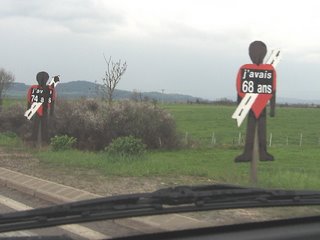 Shock tactics. Seen though the car window as we drove past, Auvergne
Shock tactics. Seen though the car window as we drove past, AuvergneWe reached the pleasant town of Issoire, last visited briefly when we called off some years ago to deliver a wedding present to Danielle and Joel's son Stephane when he was serving here with the French army. Here we found the 16th century house on the main square where Gabriel-Roux was born in 1853. He was apparently the first to discover the antibiotic properties of penicillin, paving the way for subsequent research by Alexander Fleming.
 House of scientist Gabriel-Roux, Issoire, Auvergne
House of scientist Gabriel-Roux, Issoire, AuvergneThe 12th century abbey church of St. Austremoine is well worth a visit, again being constructed in Auvergne style with columns, carved capitals and an attractive apse decorated on the exterior with carved signs of the zodiac. Inside, during the 19th century it has been entirely painted and decorated, the figures on the capitals being carefully picked out and the columns painted with vines, leaves, flowers and patterns. It would probably not be a good plan for all churches to follow Issoire's example but Jill found it made a refreshing change bringing warmth and interest to the stone carvings and bare columns. But Jill is rather a philistine concerning such matters whilst Ian is a purist finding it less agreeable.
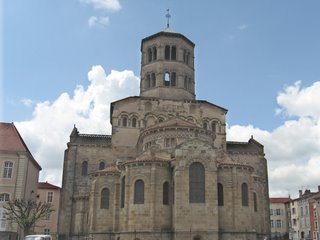 St. Austremoine, Issoire, Auvergne
St. Austremoine, Issoire, Auvergne Detail of the apse showing zodiac signs, St. Austremoine, Issoire, Auvergne
Detail of the apse showing zodiac signs, St. Austremoine, Issoire, Auvergne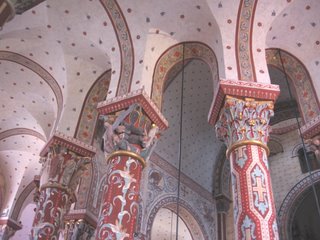 Painted interior of St. Austremoine, Issoire, Auvergne
Painted interior of St. Austremoine, Issoire, AuvergneBelow in the crypt is the reliquary holding the remains of St. Austremoine who brought Christianity to Issoire in the 4th century. The tiny casket is 13th century enamelled Limoges work. In 1983 it was stolen and after a chequered history that took it via Alaska it turned up in an antique shop in Honolulu in 1992! It is now back in the church, secure behind a heavy iron grill.
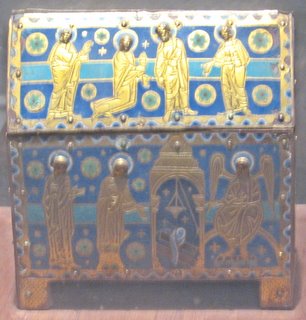 Reliquary of St. Austremoine, Issoire, Auvergne
Reliquary of St. Austremoine, Issoire, AuvergneFinding internet access poses difficulties as we travel around. Here we found an excellent place with good fast machines to load our blog and check messages. By this time we needed to seek out the Issoire pissoir. The only one we found was a self-cleaning electronically operated €uroloo where you are afraid of never getting out, the doors opening automatically before you are ready to leave, or worse still, the whole disinfecting process starting with water spraying everywhere while you are still inside contemplating! Today though, it wasn't functioning at all and our money was rejected. The good thing was that it gave us back twice what we put in! Playing the pissoir machines of Issoir gives a better return than playing the machines à sous at Royat!
Moving on from Issoire we made our way towards Le Puy en Velay. As we travelled the rain started and became heavier as the afternoon wore on. Around 6pm we discovered the little village of Polignac built up around the vertical sides of a volcanic stack with a castle on the top. The name means place of Apollo and was a Roman place of worship. Pilgrims would arrive in a room at the foot of the rock where they were expected to utter their requests aloud, unaware that a funnel-shaped well in the rock carried their voices to the top. By the time they had struggled up the cliff to the oracle, priests had worked out a suitable response and using a form of hidden megaphone, made it appear to the astonished pilgrim that the response came directly from the mask of Apollo!
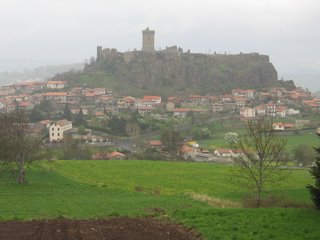 Polignac, Auvergne
Polignac, AuvergneIt was not our intention to revisit Le Puy en Velay (see blog for around 22nd October 2005) and the rain was now very heavy, so we made our way here to Monastier for the night.
Friday 28th April 2006, Avignon
Well here we are back at the same campsite we used at Avignon over the New Year – remember the photo of the bridge at midnight on New Year's Eve? We are not actually retracing our steps. Last time we made our way east as far as here before returning to Ambre-les-Espagnolettes and continuing west around the Iberian Peninsula. This time we intend picking up our travels from the same spot and heading east towards Italy – we are slowly getting there! This site pleased us greatly on our last visit so why search around for somewhere different? It's a familiar, friendly place for two temporary exiles and feels a little like coming home!
Last night the rain fell heavily at Le Monastier and we woke to a sodden world with swirling fog. Before moving on we went to the tourist office with a little note about our blogsite, citing the reference of our visit last October at the start of our journey along the Stevenson trail. We briefly showed the young woman on duty the site with photos of the town and mentioning the incident of getting locked in the castle. (Archive is 25th October 2006 if anyone is interested.) She was very polite to us but no doubt thought "oh no, not another lot!" Still, maybe the Mairie will be interested, one never knows and the photos of the town were not half bad!
We left the town and followed what we imagine must be a superb route through the mountains of the Cevennes and the Ardèche. From time to time a break in the clouds gave us wonderful vistas of the surrounding hills but generally we were driving through thick mist along very twisting roads with sheer drops to the side, marked out by bright orange poles just visible as we snaked our way through the mountains of the Ardèche. Fortunately few vehicles frequented roads at this altitude of about 1,200 metres. At one point we entered onto a level plateau and the fog listed to reveal a landscape of meadows smothered as far as the eye could see with tiny mountain daffodils! Almost immediately though, the mist closed in again and we were driving with maybe only 10 metres visibility. It was an exhausting experience but eventually the route wound its way down to around 800 metres and we were below the fog, our route bordered by almond and chestnut trees in blossom.
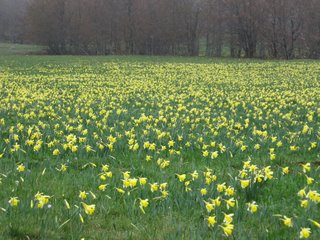 A host of dancing daffodils, Auvergne
A host of dancing daffodils, Auvergne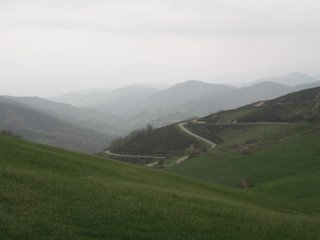 The volcanic landscape of Vivarais, Ardèche
The volcanic landscape of Vivarais, ArdècheThe Auvergne, the Cevennes and the Ardèche are all volcanic but the geology of the area is far to complex to understand on such a cursory visit. It is frustrating to see limestone in a volcanic area and not understand why. None-the-less, together these three areas form an area of breathtaking grandeur and beauty. Somewhere up here we crossed the watershed separating the Mediterranean from the Atlantic. We are now truly back in southern France!
We descended, seemingly forever, down and down into the town of Privas, capital of the Auvergne region and famed for the production of marrons glacés. Here we stopped to feed Modestine, find some lunch for us and to recover from so many kilometres amongst the foggy peaks. Hyper U on the town's outskirts solved all our problems with cheap fuel for Modestine and even cheaper fuel for us with limitless supplies of wonderful Mediterranean vegetables such as courgettes and aubergines baked in cream!
As we have moved down from the cold bare mountains to the warmer but windier valleys we have noticed a change in the plants. Down below the roadsides are full of red poppies, there is cherry blossom, flowering current bushes, orange blossom and wisteria.
From Privas we continued south along far less pleasant routes with steadily increasing traffic along the Rhône Valley to Montélimar, famous for the production of nougat. Here we briefly explored the town, climbed up to the castle and investigated a nougat factory. Unfortunately for us all they seemed to be doing this afternoon was wrapping it but we were offered a free sample. It is made using almonds from all those pretty blossoming trees we saw in the mountains, as well as honey produced from bees gorged with the lavender of Provence!
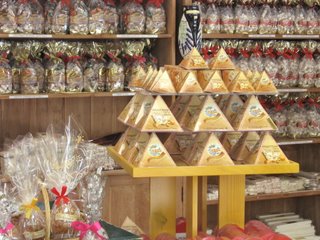 Nougat shop in Montélimar
Nougat shop in MontélimarJill was disappointed that there was insufficient time to visit the crocodile farm we passed on our way south to the acclaimed Roman town of Orange. Whether the town is famed for its oranges we don't know. Certainly it has a large mobile phone shop of the same name! By the time we arrived a really strong wind had developed which roused huge clouds of dust from the sandy streets that irritated our throats, eyes and noses. Our impression of Orange is that it is a town of huge traffic jams, huge Roman remains and absolutely no toilets.
Certainly the Roman triumphal arch at the entrance to the town is most impressive, as is the Roman theatre on the opposite side. Ian was very disappointed on entering the theatre however, to discover that the whole place is in process of restoration and he saw little but scaffolding. The best views were from the exterior.
 Roman triumphal arch at the entrance to Orange
Roman triumphal arch at the entrance to Orange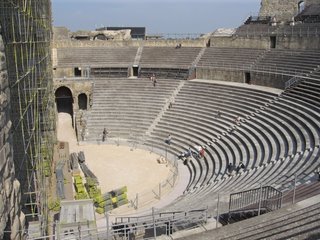 Roman theatre! Orange
Roman theatre! Orange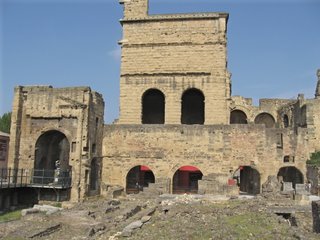 Side view of the Roman theatre across the temple, Orange
Side view of the Roman theatre across the temple, Orange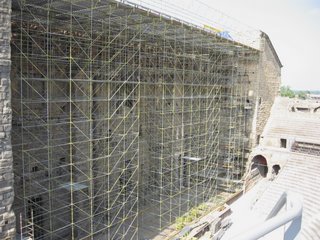 An impression of the scale of the restoration work being undertaken at the Roman theatre! Orange
An impression of the scale of the restoration work being undertaken at the Roman theatre! Orange Exterior of the Roman theatre! Orange
Exterior of the Roman theatre! Orange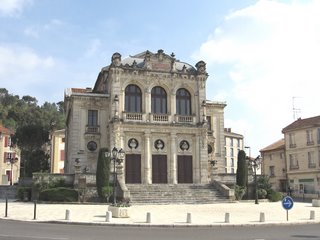 The delightful and rather more recent theatre, Orange
The delightful and rather more recent theatre, OrangeIt really was not a pleasant experience walking around the streets in a tornado of dust. Unfortunately it seems all too common in the Rhône Valley where the Mistral blows for days on end. We experienced something of it when we visited the Carmargue in January. Today it was not particularly cold, but very powerful and unpleasant. We felt quite nervous walking the streets of Orange for fear of pots or tiles being hurled into the streets below.
So although Orange is probably a very pleasant town on an empty bladder when the Mistral is not blowing, we left the town without regret, making our way directly down to Avignon where we somehow negotiated the evening traffic to reach this now familiar campsite on the island in the Rhône with views across to the Palace of the Popes. We have been confined to Modestine for most of the evening as the wind is continuing to howl outside, tossing the leaves on the plane trees that offer welcome shade in the summer and sending eddies of sand and dust into the air so that our eyes are permanently sore and itching.
Saturday 29th April 2006, Beaurecueil, Luberon
All night the wind howled and ripped at the high treetops of the campsite at Avignon. We were rocked to sleep as Modestine swayed with the fierce buffets against her sides. Today it continues unabated though the sun is shining brightly.
We reluctantly decided not to spend the morning in Avignon. Just the thought of walking across the bridge from our island in the middle of the Rhône in a powerful wind decided us that it was impractical. There was absolutely no pleasure to be gained anywhere in such a gale. Our eyes hurt and we were sneezing from the dust and pollen. So we made our way towards Aix-en-Province hoping to leave the wind behind. The route was not particularly pleasant and we were fast becoming disillusioned with the myth put about by writers and estate agents that Provence is a land of sunshine, lavender and timeless mountain villages with stupendous views over vineyards. Eventually deciding there had to be more to this corner of France we turned off the route nationale and made our way up into the hills. This was indeed far more pleasant and we passed through several nicely maintained villages of ochre coloured houses with lavender shutters, pretty gardens and vistas of bare white hillsides.
The wind did eventually cease and we were able to travel the twisting road up to the friendly, sunny little town of Apt with its quaint shady pedestrianised streets of tourist shops selling local produce, faience and brightly patterned yellow and blue tableware so evocative of Provence. The Cathedral stands in the centre of the shopping area and is huge for such a tiny town! It has two crypts, a fourth century one beneath one from the eleventh century.
So many little towns seem to have suffered failed attempts at civic grandeur. In the municipal gardens at Apt it was the town fountain! Originally intended to be a complex metal sculpture, funding proved insufficient and it was decided to build a rustic rockery instead. This turned out to be very ugly, though it has been moderated by moss, lichen and time. As soon as it was inaugurated in the 1880s it was nicknamed the Elephant Fountain and the water trough filled with vegetables to feed the elephant! Nearby this afternoon a pétanque match was being eagerly supported by the town's menfolk.
 Pétanque match in front of the elephant fountain in Apt
Pétanque match in front of the elephant fountain in AptWe continued through the mountains of the Luberon, finding it very pleasant with sunny vistas to bare mountains while fields, orchards and vineyards covered the valley floors. It reminded us very much of the Languedoc around Ambre though it had been winter while we were there. Presumably now it too would have hedgerows filled with poppies, dried grasses and lilac.
 Poppies in the Luberon
Poppies in the LuberonEventually we neared Aix-en-Province and faced the problem of finding a campsite for the night. Unfortunately they were all on the far side of town and French signing is pretty useless so we ended up getting completely lost, channelled onto the motorway and forced along in the direction of Nice. When we eventually extricated ourselves and found the only two sites in the area they were expensive and not very nice. So we decided to head towards Aubagne, Marcel Pagnol country, in the hope of finding a site by chance on the way. This was definitely a good move. We have found a delightful site in the countryside with spectacular views to the stark bare Montaigne Ste Victoire, white and rugged against the blue sky. It turned a rosy pink as the sun set and we sat drinking wine beside a flowering lilac.
We bought a tiny electric cooker when we were back in England. During the afternoon today we investigated the charcuterie of one of the sunny Provencal villages and this evening we have experimented with cooking stuffed tomatoes and onions with battered aubergines on a table outside Modestine's back door. Supper was delicious and the view quite magnificent.
Sunday 30th April 2006, Beaurecueil, Luberon
We are still on the same campsite after spending a very pleasant day exploring Aix-en-Provence and the countryside and little villages of this magnificent, picturesque corner of Southern France.
This is Cezanne country! There are way-marked routes around the hills marking the points where he painted local scenes vibrant with colour. Paul Cezanne was born and died in Aix-en-Provence and this is the centenary year of his death. Consequently there is much publicity and razzmatazz in the town with free videos about his life and work being shown at several public buildings. One of his most important works – or rather 45 of them as he seemed obsessed with painting the same view – is of the huge, grey, bare mountain of Sainte Victoire which we are looking up at through Modestine's window as we write! As at this time last night, it has turned rosy from the reflected rays of the setting sun and it is easy to realise why Cezanne found such endless fascination and frustration in endeavouring to capture its different moods and colours. During the afternoon in Aix we walked up to his studio overlooking the town. There is little to see except the large grey-walled room in which he created so many of the still-life paintings now adorning the walls of art galleries around the world. The props for his works are all on broken benches, just as he last used them. It is strange to see the original simple dishes, pots, chairs and ornaments immortalised in his paintings, still scattered around his studio over 100 years later!
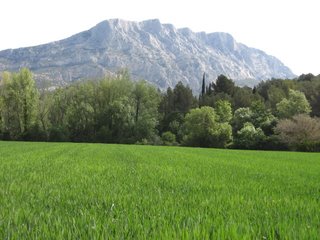 Montaigne de Sainte Victoire seen from our campsite
Montaigne de Sainte Victoire seen from our campsite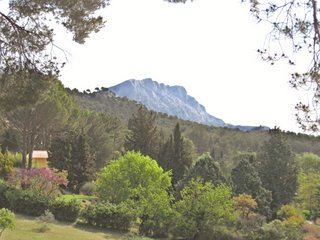 Ian only managed a couple of views of Sainte Victoire
Ian only managed a couple of views of Sainte Victoire Cezanne's house and studio, Aix-en-Provence
Cezanne's house and studio, Aix-en-ProvenceAix is a much nicer place than we imagined after our frustrating attempt to navigate through it last night. The campsite gave us a map so we were able to park on the edge and walk in. Admittedly it is a bank holiday Sunday but one gets the impression that the entire town centre is given over to eating, drinking and relaxing on warm sunny terraces. It has some beautiful public buildings, shady squares and several refreshing fountains including a hot one from a thermal spring. Everywhere there are references to Cezanne. On the Cours Mirabeau with its avenue of plane trees is the Café des Deux Garçons which he used to frequent. Today it is smarter and more expensive than a hundred years ago so we enjoyed our coffee on the equally nice terrace of an adjoining café instead.
 Café des Deux Garçons, Aix-en-Provence
Café des Deux Garçons, Aix-en-Provence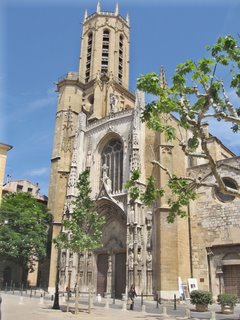 Cathedral, Aix-en-Provence
Cathedral, Aix-en-Provence Place d'Albertas 1745, Aix-en-Provence
Place d'Albertas 1745, Aix-en-Provence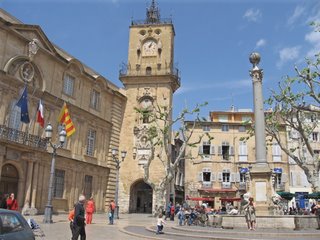 Hôtel de Ville, Aix-en-Provence
Hôtel de Ville, Aix-en-ProvenceThe writer Emile Zola also comes from Aix though there is far less publicity paid to him. He wrote about Aix under the name of Plassans. He was actually at school with Cezanne and they were friends for many years.
Very near to this campsite is the little village of Le Tholonet with its windmill immortalised by Cezanne. It is a pretty little place and today there was a festive atmosphere with a massive vide-grenier (car boot sale). These are a fairly recent phenomenon in France where they have been accepted with enormous enthusiasm. Apart from countless stalls selling an unbelievable assortment of junk at surprisingly high prices, there was a large mobile canteen set up selling beers, coffees, spicy hotdogs and apple tart. A massive area was filled with vehicles and thousands of people had travelled out from Aix, obviously intent on spending the day in this little village. A nearby country house is now the headquarters of the company charged with maintaining the Canal de Provence. This carries drinking water from Verdon on the northern side of the mountains to serve the cities of Marseilles, Aix and Toulon. To do this the canal had to be cut right through the mountains, an enormous engineering feat, so much of the canal actually flows underground.
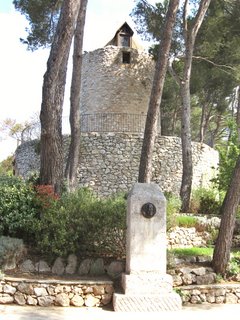 Windmill stump painted by Cezanne, Le Tholonet
Windmill stump painted by Cezanne, Le Tholonet Car boot sale, Le Tholonet
Car boot sale, Le Tholonet Headquarters of the canal company, Le Tholonet
Headquarters of the canal company, Le TholonetThe countryside away from the arterial roads and major conurbations really is very pretty, full of warm bright colours. Hedgerows are in flower and there are deep pink blossoms on the trees contrasting brightly with the vivid green of new leaves. The soil, where it is exposed, it bright red and the houses nestling amongst the fields have heavy pink tiles and pale ochre coloured walls with lavender or pale blue shutters. Higher up the hills are grey and bare. We have not ventured up there. The roads are steep, twisting, narrow and very busy with weekend traffic.
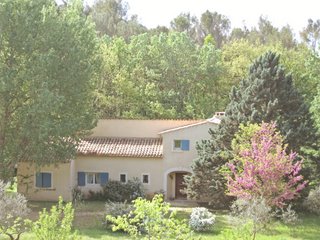 A home in Provence, near Le Tholonet
A home in Provence, near Le Tholonet